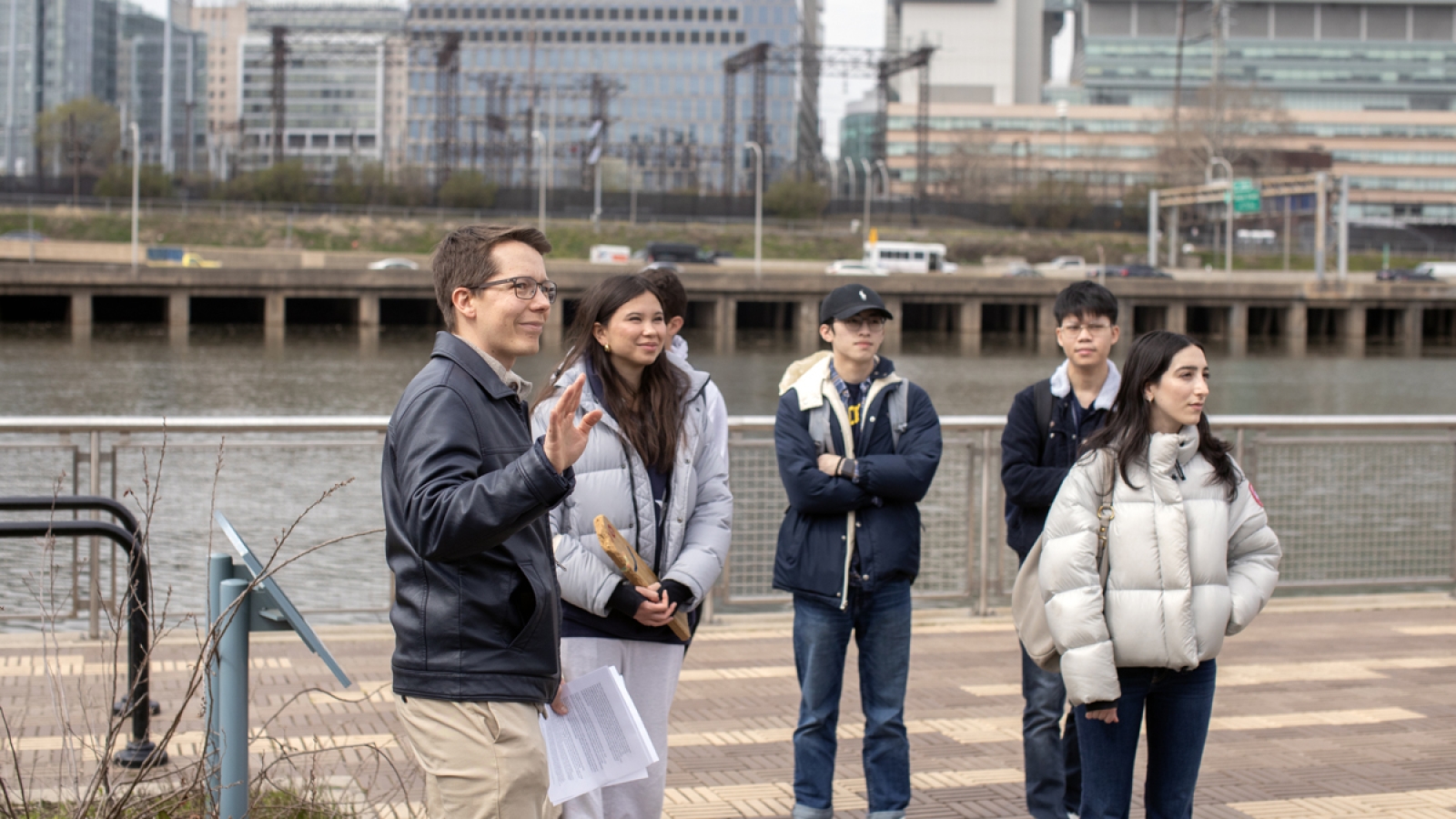John Kanbayashi is walking backward and talking about the Schuylkill River. The small group of students enrolled in his River History seminar follow attentively. Beside them is the river itself, brown and slow under a cloudy sky. On their other side are railroad tracks—a freight train drowns out Kanbayashi for a few minutes—and across the water, traffic on the Schuylkill Expressway moves almost as slowly as the river.
The original banks of this section of the Schuylkill are long gone, replaced by concrete as humans molded it to their needs. But the river hasn’t always cooperated—it flows too slowly to carry away the waste dumped into it in the 19th century. Schuylkill means “hidden river” in Dutch, and for a while it was hidden from most Philadelphians by the refineries, factories, and abattoirs around it.
“You couldn’t always see the river,” says Kanbayashi, an assistant professor in History and Sociology of Science, “but you could smell it.”
Rivers are multifunctional by nature. They provide resources and transportation, often gateways to prosperity for societies, but they resist even the most sophisticated attempts at human control. They can also be political and religious symbols, technical objects, and historical forces. Students in Kanbayashi’s seminar are using literature, film, and historical sources to explore these functions, examining rivers around the globe and how diverse societies have understood and employed them. Now, Kanbayashi is going a step further and bringing the class from Williams Hall to the Schuylkill to take in the river and its surroundings as he describes its role in the narrative of Philadelphia and Pennsylvania.
A historian of environment, science, and technology, Kanbayashi was inspired to create a history seminar organized not around a place or period, but a theme. “I thought it could be an opportunity to get students to cut across a lot of contexts and think about what might be distinctive or unique and what seems to be broadly shared,” explains Kanbayashi. He’s also introducing them to “the work of doing history, looking at primary sources and into difficult debates.”
One of the easy takeaways about history is that it offers a lot of lessons in humility. But there are lessons of success and hope as well.
Each week or two the class focused on a different river around the world. After examining related literature and film, the students each wrote a blog post that facilitated a group discussion during class time. “I really, really enjoyed the structure of the class, because it allowed me to fully immerse myself and understand the material,” says Nika Sadeghi, C’26. The small seminar size also gave each student more “airtime,” she says. “We got to where we embraced that opportunity to put yourself out there and just explore and fully engross yourself in the material. Everyone contributed and built on each other.”
In one of these exchanges, the students held an in-class debate on the Three Gorges Dam in China that drilled down into many of the issues covered by the class. They looked at the hydroelectric power and opportunities the dam would provide but also at concerns ranging from compensation and new housing needed for displaced people to loss of cultural artifacts, environmental effects, and national security implications.
Kanbayashi assigned students to be pro or con for the in-class debate, but they eventually had to choose their own side for a written opinion piece. “The op-ed was different from a normal paper where you’re just stating and analyzing information,” says Sadeghi. “It was hard to choose to be for it or anti it because we learned so much about the advantages and the down sides.”
For their final project, students selected a river and wrote its biography, deciding how they wanted to organize their histories, and then finding and interpreting resources, but, says Kanbayashi, “also trying to be critical of them or maybe asking a question that is different.” Sadeghi focused on the Ganges River in India. “It is a huge cultural symbol, and it has great meaning in Hinduism, but it’s one of the most polluted rivers in the country,” she says. “I was really excited to explore that juxtaposition.”
Beyond looking at ways humans and rivers have interacted in the past, Kanbayashi also addressed new issues related to climate change, given that this generation of students will be faced with a range of environmental issues—no matter what path they end up taking.
“One of the easy takeaways about history is that it offers a lot of lessons in humility,” Kanbayashi says. “But there are lessons of success and hope as well.” While studying the Bengal Delta, for example, they learned about people there who move constantly among islands that are formed and reformed when the rivers shift course.
“Thinking about how people live amidst changing environments is becoming more critical with climate change. But that’s something that has always been the case,” Kanbayashi continues. “The stories we can tell are not just of hubris. There are all sorts of stories of adaptations as well. We need to resist master narratives and bring a multiplicity of perspectives.”
Rivers aren’t just bodies of water that flow through environments where people live, Sadeghi adds. “They are multifaceted and have so many different roles and purposes for communities, individuals, states, and countries. We’ve learned how rivers can create enormous distress by flooding or by being dammed. The reverse can be true, too; they can be used for development or be religious symbols. Before this class, I never thought about the pivotal presence rivers can have in global conflicts and in global resolution.”




